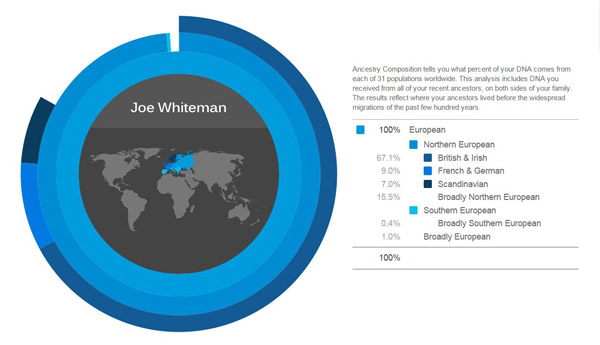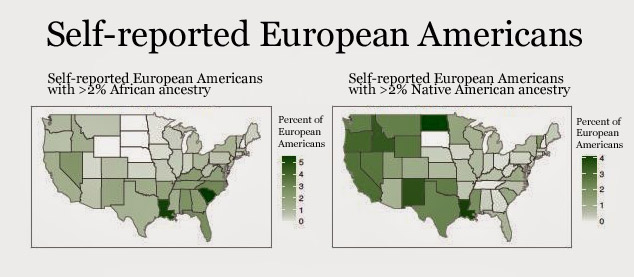White Advocate Has Genes Crunched
John Ingram, American Renaissance, February 27, 2015
If it’s true that “there is not a truth existing which I fear or would wish unknown to the whole world,” then no one should fear knowing his racial ancestry. These days it is easy to find out. You sign up online, they send you a vial to spit in, you cork it along with a preservative, send it back, and wait. I paid $98.
Still, I was slightly anxious when the message arrived from ancestry.com telling me that my DNA analysis was complete and that I could find out my ancestry with a single click. I think it’s natural to worry that there might be something you didn’t suspect. I suppose many people claim not to care, but I wonder if they’re being honest.
Not that the fact of non-white ancestry would have been a great problem, but it would have been a jolt. All my life I’ve understood that I’m white. I look white. I identify as white. Others consider me white. I’ve been discriminated against for being white–yelled at on the subway for being white. My birth certificate says I’m Caucasian.
As a white advocate, I’ve read tons on the topic of race–biology, evolution, anthropology, history, politics. And all the while, I assumed I counted as white. Anti-white discrimination affects me, anti-white crime targets me, anti-white propaganda insults me. I’m worried about the dwindling numbers of whites in the West because I am, myself, white.
So it might be jarring to find out that on the subway I should have yelled back, “Yo! I’m part black! Look, I have the printout!” Not that it would have done any good. And did I waste my weekend listening to Sam Francis, because he wasn’t really talking about me?
OK, I’m being dramatic, because it turns out I’m 100 percent European. Half, though, give or take a few percentage points, is Irish. That surprised me because I was aware of only scant Irish ancestry, and many of the names in my family tree trace back to England. Ancestry.com explains that migration may account for this: Ancestors who were originally Irish but moved to England during the potato famine, for example, stayed a few generations, and became “English.”
The Irish are a Celtic people who originated about 2,500 years ago in Central Europe, and spread outward in many directions, including to the British Isles. Only in places like Wales and Ireland were they able to resist Roman expansion.
My next biggest ethnic category, at 39 percent, was described as “West Europe.” This is basically France and Germany, along with Belgium, the Netherlands, and Switzerland. Mixture is common in this region, because it was less genetically isolated.
The next category, something else I didn’t know about, was Scandinavia at 5 percent. I had one clue about this: There is a history of hemochromatosis in my family, which is a blood affliction sometimes known as “the Viking disease.”
Also at 5 percent was “Finland/Northwest Russia.” Again, I had no idea. I have found no Russian or Finnish names in my family tree, though one ancestor was interested in Russian Orthodoxy. But, like the Vikings, it sounds cool.
The rest of my ancestry was made up of what ancestry.com calls “trace regions,” in amounts of one to two percent: Iberian Peninsula (Spain), Great Britain, Italy, Jewish, Greece.
Ancestry.com has a disclaimer on these, though: “Because both the estimated amount and the range of the estimate are small, it is possible that these regions appear by chance and are not actually part of your genetic ethnicity.” Still, it stokes the imagination. I managed to hit every European genetic category but one: Eastern Europe.
Most people don’t know much about their ancestry, and what some people think they know is wrong. I’d like to know if the three or four pretty obviously white people I know who claim Indian (Native American) ancestry actually have it. Now you can find out for sure if great-grandmother was really was a Navajo princess.
A genealogist of the kind that studies documents once told an acquaintance of mine that whenever he had been asked to look for Indians he couldn’t find any. When he reported the results, his clients were furious: “My family has known this for years!”
But DNA doesn’t lie.
With Ancestry.com, the rest of the planet outside of Europe is divided into Africa (with a dozen or so subsets–they can apparently distinguish between Cameroonian and Nigerian), Native American, Asian (East, Central, South), Pacific Islands, and West Asia (Middle East and Caucasus). All this knocks flat the idea that “race is just a social construct.” Race is real; it’s burned into your DNA.
But suppose I were 10 percent Asian, African, or Middle Eastern. Would my identity change? Would I still be a white advocate? We are constantly told that race is meaningless because “everyone is a mix,” but even people with mixed backgrounds have a dominant identity. Barack Obama is half-white and half-black. Eric Holder looks to be about the same mix. But they clearly have a dominant identity that is black.
Even if I were a mix it would still be true that race is real, and races are different. Racial differences in intelligence and behavior would remain, as would the inherent instability of multiracial societies.
I wonder how many people really are a “mix,” anyway. It is true that American blacks are, on average, about 20 percent white, but I suspect that most other people show up with ethnic backgrounds like mine that arise from a single region. Interracial marriage is still fairly uncommon.
One benefit of ancestry.com is that after you take its test it introduces you semi-anonymously to people who are likely to be related to you. Ancestry.com compares their genetic profiles to yours and lets you send messages to people who have similar markers. I was presented with a long list of people who are “very likely” to be my fourth or fifth cousins. It’s up to me whether I get in touch, or to reply if they do.
Maybe you are my fifth cousin.
The company that ran my test, Ancestry.com, started out as a website that helps you build your family tree. It links to huge genealogical databases, and lets you share your research with others. Genetic testing is a recent sideline. The biggest company in personal genetic testing is 23andMe, which started in 2007. That year, their test cost $999; now it is $99. Like Ancestry.com, 23andMe charts ancestry by continent and ethnic group, but concedes that really precise categorizations are speculative. A broadly “conservative” categorization of this typical WASP would probably be pretty accurate: 1.2%: Unassigned 98.8%: European Of which: 14.0%: British & Irish 63.8%: Broadly Northern European 21.0%: Broadly European 23andMe’s more “speculative” categorization of the same person–and one that might contain errors–is this: 100%: European Of which: 67.1%: British & Irish 9.0%: French & German 7.0%: Scandinavian 15.5%: Broadly Northern European 0.4%: Broadly Southern European 1.0%: Broadly European There is no telling how accurate the national components are, but they make for amusing speculation. It is good that testing of this kind has become so cheap. Most whites will see that their genes come exclusively from Europe–that they are white and nothing else. This can only strengthen the idea that they are a distinct people with a distinct identity. |

















